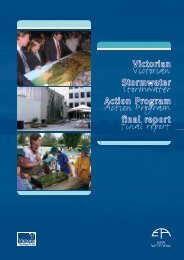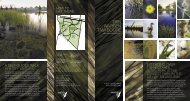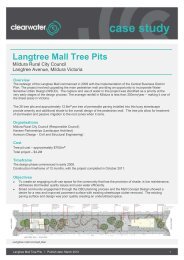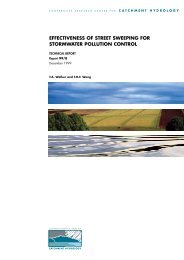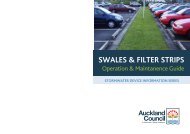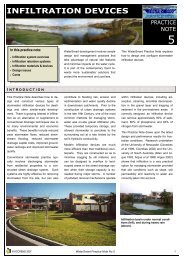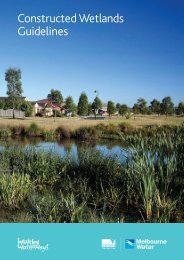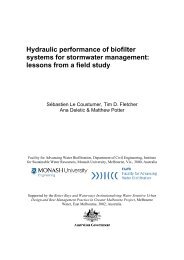Water Sensitive Urban Design( 1.07 MB ) - Clearwater
Water Sensitive Urban Design( 1.07 MB ) - Clearwater
Water Sensitive Urban Design( 1.07 MB ) - Clearwater
Create successful ePaper yourself
Turn your PDF publications into a flip-book with our unique Google optimized e-Paper software.
<strong>Water</strong> <strong>Sensitive</strong> <strong>Urban</strong><br />
<strong>Design</strong> (WSUD)<br />
For large scale developments<br />
or small scale/one off projects.<br />
Port<br />
Phillip<br />
Bay<br />
1<br />
3<br />
4<br />
2<br />
7<br />
8<br />
5<br />
6<br />
Development of this brochure was a joint initiative<br />
between Melbourne <strong>Water</strong> and Knox City Council.
What is <strong>Water</strong> <strong>Sensitive</strong> <strong>Urban</strong> <strong>Design</strong>?<br />
<strong>Urban</strong> planners and engineers are looking for ways to<br />
make better use of water in our expanding cities. As<br />
Australia’s rainfall and runoff are among the world’s most<br />
variable, it makes water management very challenging.<br />
A best practice approach to urban stormwater<br />
management is rapidly evolving – water sensitive urban<br />
design (WSUD) that provides for the sustainable<br />
management and improvement of water quality entering<br />
Melbourne’s waterways from urban regions; opportunities<br />
for stormwater and greywater harvesting and reuse; and<br />
innovative reductions in potable water demand. Through<br />
collaborative efforts between councils, developers and<br />
other relevant regulatory authorities, WSUD is being<br />
incorporated into urban developments and road designs<br />
across Victoria.<br />
WSUD contributes to urban sustainability and provides<br />
the conditions for attractive, human-scale living<br />
environments through integration of urban planning and<br />
design with the management, protection and<br />
conservation of the whole water cycle.<br />
1 Rainwater Storage Tank<br />
From Roof<br />
First Flush Converter<br />
Overflow to stormwater<br />
or garden<br />
Pump to toilet or<br />
garden irrigation<br />
Key Principles of WSUD<br />
Consistent with the <strong>Urban</strong> Stormwater: Best Practice<br />
Environmental Management Guidelines (CSIRO 1999),<br />
the key principles of WSUD from a stormwater<br />
management and planning perspective are:<br />
Protect natural systems – protect and enhance natural<br />
water systems (creeks, rivers, wetlands) within urban<br />
developments<br />
Protect water quality – improve the quality of water<br />
draining from urban developments into creeks, rivers<br />
and bay environments<br />
Integrate stormwater treatment into the landscape –<br />
use stormwater treatment systems in the landscape<br />
by incorporating multiple uses that will provide multiple<br />
benefits, such as water quality treatment, wildlife<br />
habitat, public open space, recreational and visual<br />
amenity for the community<br />
Reduce runoff and peak flows – reduce peak flows from<br />
urban development by on site temporary storage measures<br />
(with potential for reuse) and minimise impervious areas<br />
3 Swale Vehicle Crossing<br />
Agricultural Drain<br />
Service Conduits<br />
Geotextile fabric<br />
Slotted/Porous PVC Pipe<br />
Add value while minimising development costs –<br />
minimise the drainage infrastructure cost of development<br />
Reduce potable water demand – use stormwater as a<br />
resource through capture and reuse for non-potable<br />
purposes (e.g. toilet flushing, garden irrigation, laundry).<br />
Why implement WSUD?<br />
WSUD provides a range of measures to help address the<br />
environmental degradation that flows from traditional practices<br />
of stormwater management. WSUD is about designing our<br />
urban environments to more closely match the original water<br />
cycle that exists, prior to development. It is about:<br />
Trying to more closely match the pre-development<br />
stormwater runoff regime – both quantity and quality<br />
Optimising the use of rainwater that falls on our urban areas<br />
Reducing the amount of water we transport between<br />
catchments, both in water supply import and<br />
wastewater export.<br />
5 Vegetated Swale/ Bioretention Trench<br />
Geotextile fabric<br />
Filter media (sand/gravel)<br />
for stormwater treatment<br />
Slotted/Porous PVC Pipe<br />
WSUD Applications<br />
WSUD applications can provide water based or natural<br />
vegetated features that add community value, while<br />
performing a treatment function through filtering of<br />
stormwater runoff. These applications include (not<br />
limited to):<br />
Grassed or landscaped swales<br />
Infiltration trenches and bio retention systems<br />
Wetlands*<br />
Rainwater tanks – stormwater harvesting & reuse<br />
Greywater harvesting & reuse<br />
Rain gardens, rooftop greening, urban forests<br />
Porous pavements<br />
* Refer to Constructed Wetland Systems <strong>Design</strong> Guidelilnes<br />
for Developers (Melbourne <strong>Water</strong>, 2002)<br />
7 Porous Pavement<br />
Course Sand<br />
Paving Blocks or Porous Pavers<br />
Permeable Pipe<br />
Geotextile fabric<br />
Granular Store (4-7mm gravel screenings)<br />
Where can WSUD techniques<br />
be implemented?<br />
WSUD applications can be sized up or down to suit the<br />
individual site, from a standard house block through to a<br />
whole subdivision. Appropriate planning and design will<br />
ensure successful outcomes. The range of applications<br />
available may be applied in the following areas:<br />
New road/streets in large or small development areas<br />
Existing streets and roadways<br />
Where drainage systems or pavements are to be<br />
substantially upgraded<br />
Where roadways are duplicated<br />
On publicly owned land<br />
In new residential development – detached housing,<br />
medium density or integrated housing<br />
In existing residential developments – redevelopment<br />
and infill areas<br />
Commercial or industrial properties/estates<br />
Carparks/driveways/access routes – public or private<br />
property<br />
Planning & Feasibility<br />
WSUD concepts and technologies, if planned and<br />
implemented correctly, offers an opportunity for elements<br />
of the water cycle and the development to compliment<br />
each other. In order to achieve the best possible results of<br />
implementation, the pre-planning and design phase must:<br />
Identify the land use capabilities of the development<br />
site (feasibility stage – existing conditions or limitations)<br />
Identify the likely impacts of the development on the<br />
existing environment (immediate, surrounding or<br />
downstream areas)<br />
Match these factors with the most appropriate WSUD<br />
applications, designed to achieve a balance between<br />
development and environment; so as to ensure integration,<br />
sustainability and sound management of the water cycle.<br />
Acknowledgements<br />
Melbourne <strong>Water</strong> is responsible for managing regional<br />
scale drainage and waterways in greater Melbourne.<br />
We aim to improve the quality and environmental health<br />
of these waterways as a key part of our objective to<br />
sustainably manage Melbourne’s water resources and<br />
the environment. For more information on WSUD, visit<br />
www.wsud.melbournewater.com.au or call 131722.<br />
Knox City Council, in association with<br />
MDG Landscape Architects and KLM<br />
Development Consultants, have developed<br />
WSUD Implementation Guidelines for the<br />
municipality. For a copy of the Guidelines,<br />
call Council on 9298 8000.<br />
Winner: Savewater Awards 2002<br />
Category: <strong>Water</strong> <strong>Sensitive</strong> <strong>Urban</strong> <strong>Design</strong> Project<br />
2 Grass Swale/ Bioretention Trench<br />
4 Driveway Pit & House Connection<br />
Grate<br />
Vehicle Crossover<br />
6 End of Swale/Bioretention Trench<br />
Grate<br />
Overflow – heavy rainfall events direct to grate<br />
8 Treatment Pond/Wetland*<br />
Consider the intended design and function of the<br />
proposed development<br />
Geotextile fabric<br />
Filter media (sand/gravel)<br />
for stormwater treatment<br />
Slotted/Porous PVC Pipe<br />
Invert of<br />
Swale<br />
Stormwater from house<br />
downpipes<br />
Slotted/Porous PVC Pipe<br />
Slotted/Porous PVC Pipe<br />
Filter media<br />
(sand/gravel) for<br />
stormwater treatment<br />
Inflow<br />
High flow bypass<br />
Pre-Treatment Inlet<br />
Zone<br />
Ephemeral<br />
Zone<br />
Wetland Zone




